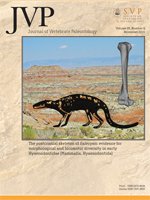A juvenile maxilla of Moropus with DP3-M1, collected from the early Hemingfordian (He1) Picture Gorge 36 local fauna of the Rose Creek Member of the John Day Formation of Oregon, U.S.A., is the best-preserved chalicothere specimen yet collected from the John Day Basin. It also provides additional understanding of early Miocene Schizotheriinae (Perissodactyla, Chalicotheriidae) in western North America. Although Coombs et al. attributed all of the John Day chalicotheres to Moropus oregonensis, the new specimen resembles in size and morphology some of its early Hemingfordian contemporaries from the Runningwater Formation of the Great Plains and is referred to Moropus sp. Moropus sp. can thus be added to the oreodont Merycochoerus magnus, the amphicyonid Daphoenodon (Borocyon) robustum, the dromomerycid Barbouromeryx, the moschid Parablastomeryx schultzi, and the equid Parahippus pawniensis as John Day taxa with close relatives in the early Hemingfordian of the Great Plains. Further, the identification of the fragmentary chalicothere fossils from the John Day Formation is made more complex by the likely presence of more than one species there during the early Miocene.
How to translate text using browser tools
1 November 2015
New Material of Moropus (Perissodactyla, Chalicotheriidae, Schizotheriinae) from the Early Hemingfordian Rose Creek Member of the John Day Formation, Oregon, U.S.A.
Margery C. Coombs,
Robert M. Hunt
ACCESS THE FULL ARTICLE





